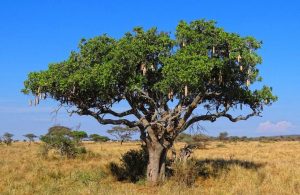Piliostigma thonningii, common name ‘camel’s foot’, is a leguminous, deciduous tree with a single stem, native to tropical Africa. It grows in open woodland, savannah regions, and wooded grassland in low to medium altitudes. It is a multipurpose tree of vast importance for health.
This evergreen species is a good shade tree that fixes nitrogen in the soil and plays vital ecological roles in nutrient cycling from this deep soil. It grows to about 5 m in height with a rough, dark brownish, grey bark surface. Its leaves are conspicuous, simple, two-lobed, and leathery; resembling a camel’s foot. This explains why the plant’s common name is ‘camel’s foot’.
It is a dioecious plant having the male and female flowers occurring on different trees in most cases. If on the same tree the male flowers occur first and then female flowers later so that self-pollination is not possible. The fruit pods are large, thick, green when unripe and turning reddish brown on ripening; they are non-splitting and measure about 30-70 mm long.
The Piliostigma thonningii (Schum.) Milne-Redh, (Fabaceae Family), is a multipurpose tree of vast health importance and almost all its parts, including the bark, root, and leaves, are used in traditional medicine to treat and manage multiple disease conditions, including cough, bronchitis, wounds, chronic ulcers, diarrhoea, toothache gingivitis, leprosy, smallpox, yellow fever, and chest pain.
The stem bark infusion is used for the cure of coughs, pneumonia, worms, colds, chest pains, internal abscesses, haematuria, and snakebite. It is also administered for the treatment and management of diarrhoea, dysentery, as well as gum infections. An infusion obtained from a mixture of the bark and leaf is used in the treatment of malaria. The bark decoctions are rubbed on or used as a vapour for the treatment of rheumatism, muscular pain and bone inflammation.
The decoction is also taken as an antiemetic. The powdered stem bark is externally applied as a treatment for wounds, ulcers and skin infections. Due to its pain-relieving activity, the stem bark is used for the treatment of sore throat, toothache, gum problems, earache, stomach-ache and general body pain. In some communities, the bark sap or the powdered bark is boiled in milk or in soup and orally administered for the treatment of gonorrhoea, a sexually transmitted disease condition. The ash obtained from burnt young Piliostigma thonningii wood is rubbed on the chest to relieve chest pains and congestions.
The fresh tender leaves and flowers of the Piliostigma thonningii tree can be chewed to treat stomach-ache, dementia, coughs, snakebite, and to quench thirst. A leaf decoction is added to bath water to alleviate body stiffness. Chewing of boiled leaves of Piliostigma thonningii is known to relieve toothache. To hasten healing, the ash obtained from burnt leaves is rubbed on snakebite wounds after scarification. The inhaled steam from boiled leaves in water is used to treat and manage respiratory problems.
Leaf preparations are also used for the treatment of diarrhoea, dysentery, worms and other intestinal problems. Pounded leaves are rubbed on the head in case of headache, whereas leaves boiled in water are rubbed on the back against lower back pain. The strained liquid from boiled leaves of Piliostigma thonningii is rubbed into incisions for the treatment of painful legs. Baths with leaf decoctions are known to relieve fever.
A decoction of the leaves is used as a vaginal wash and enema for a mother giving birth and the decoctions or infusions are taken in case of heavy menstruation. Leaf decoctions are used as a wash on fractures and the residue is used to massage the affected part to hasten healing. In case of bone inflammation, a steam bath using the leaves decoction is taken. Leaf infusions are used as anti-emetics. Leaf sap or infusions are applied for the treatment of eye problems and the paste made from ground young leaves and flower buds is diluted with water and drunk against palpitations.
The roots of Piliostigma thonningii are widely used to treat prolonged menstruation, haemorrhage and miscarriage in women and for the treatment of coughs, colds, body pain, and sexually transmitted diseases. Root preparations are applied on wounds and ulcers, as a haemostatic agent, and promotes quicker healing. The root also has the ability to treat diarrhoea, dysentery, worms and other intestinal problems.
The root preparations are used against snakebites and as an antidote to poisons. The root heated in fat is used as a poultice in case of a painful spleen. The roots decoction is used to treat rheumatism and also taken in case of heavy menstruation and a painful uterus; it is given to a mother who has given birth. Powdered dried flowers are eaten in food, smoked, or its infusion drunk to alleviate cough. The scrapings of the fruit are applied as a dressing on wounds to promote healing. The powdered fruit is used as an ingredient in preparations used in the treatment of cough, bronchitis, and headache.
The phytochemicals present in Piliostigma thonningii, including flavonoids, tannins, kaurane diterpenes, alkaloids, carbohydrates, saponins, terpenes, and volatile oils, may be responsible for its incredible medicinal potential.
Apart from the medicinal uses, the pods and seeds of Piliostigma thonningii have been used as a source of food in some communities. In fact, the powder made from the dry pod pulps is used for making nutritious porridge. The pulp has a sweet flavour and is eaten mainly by children and travellers. Unripe pods can be used as a substitute for soap.
(Richard Komakech)






